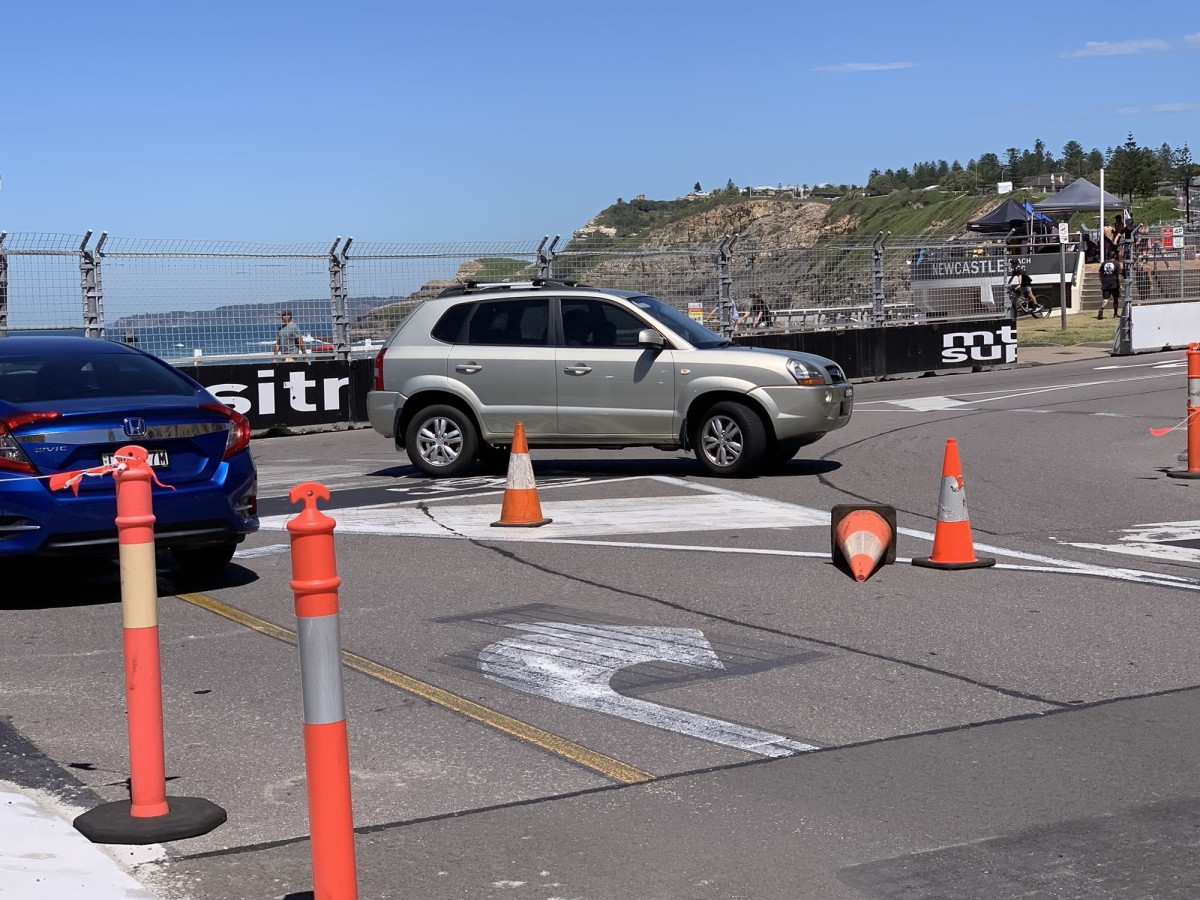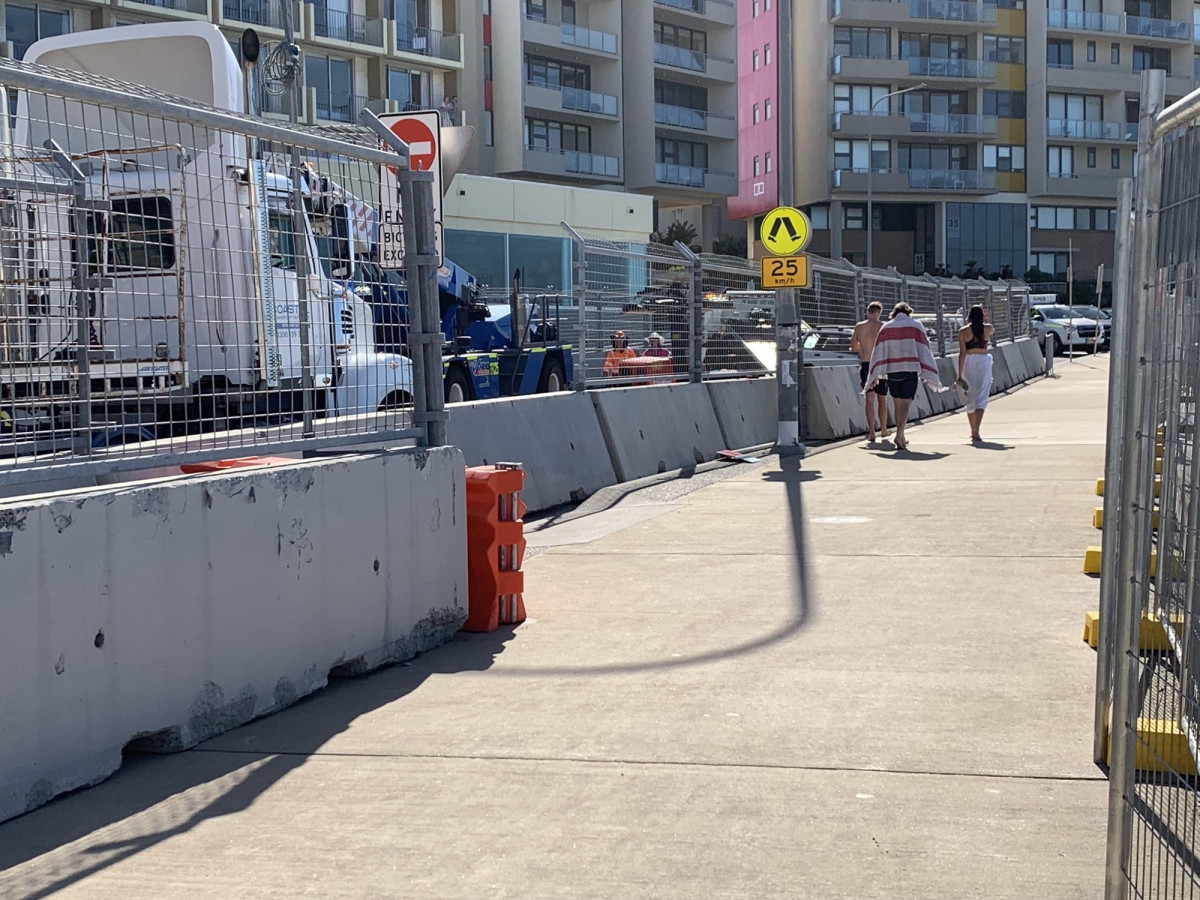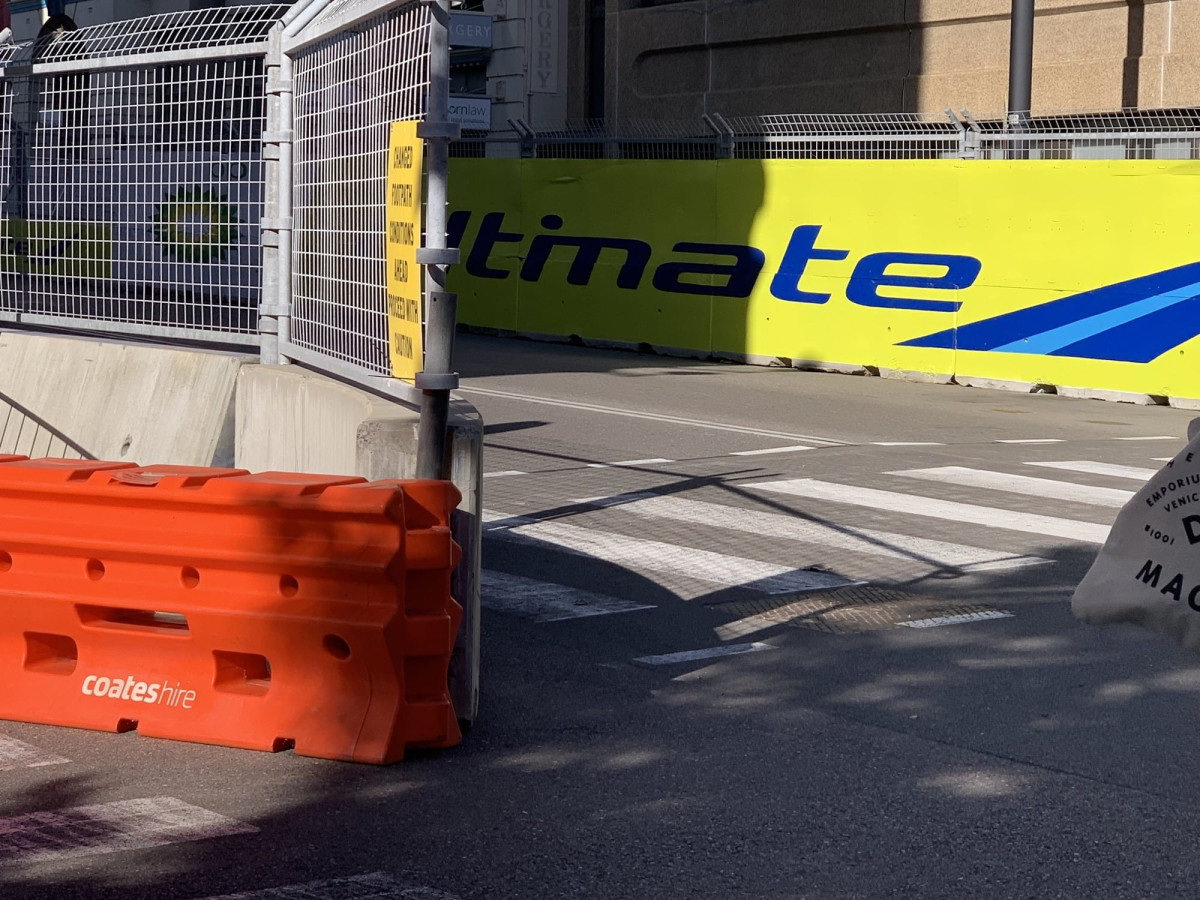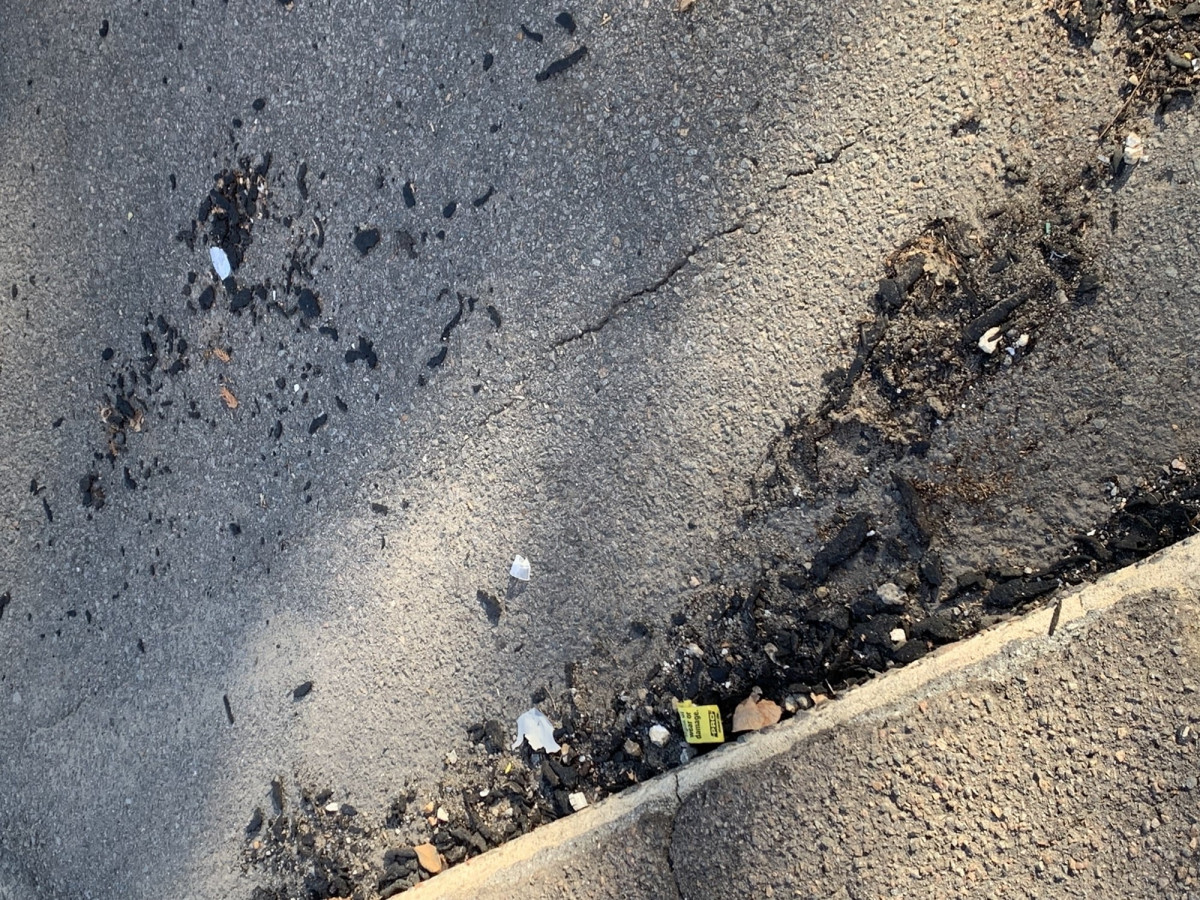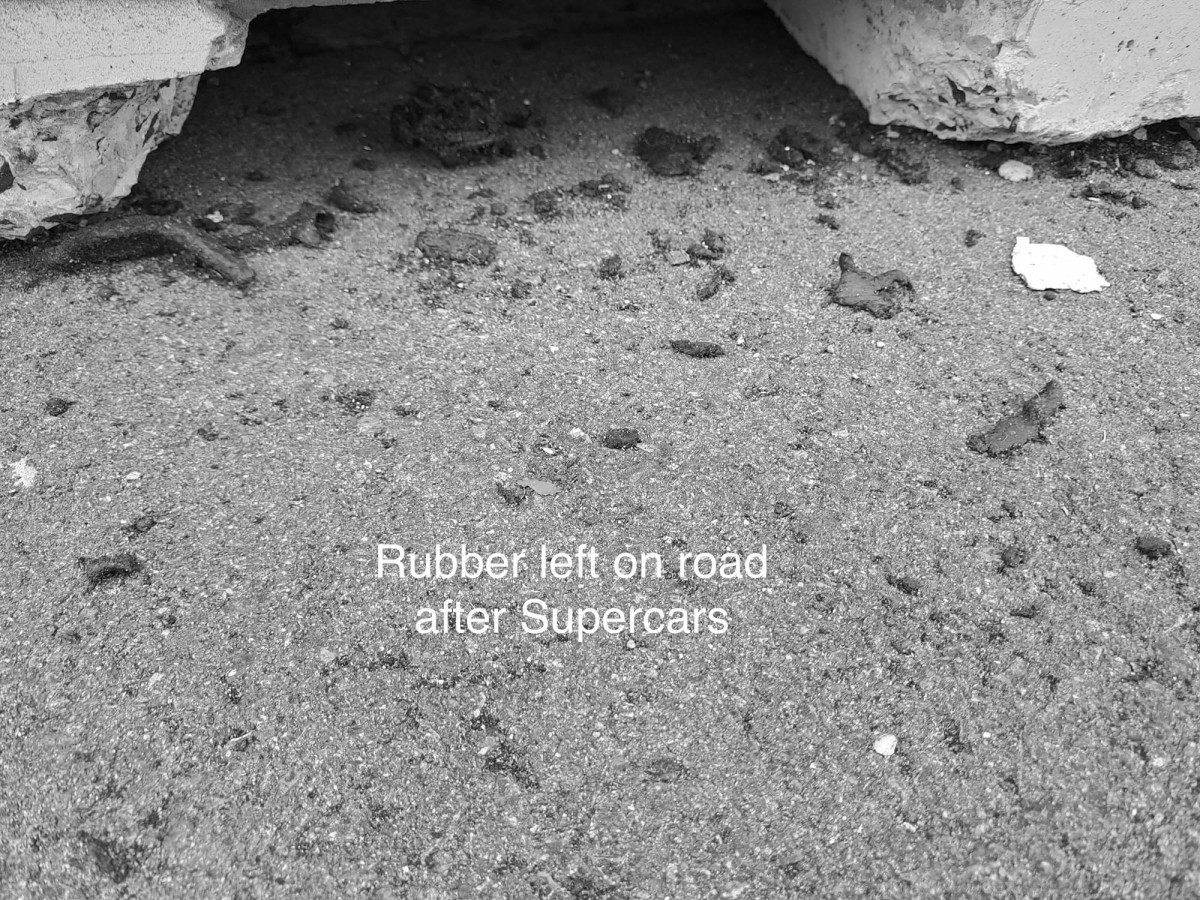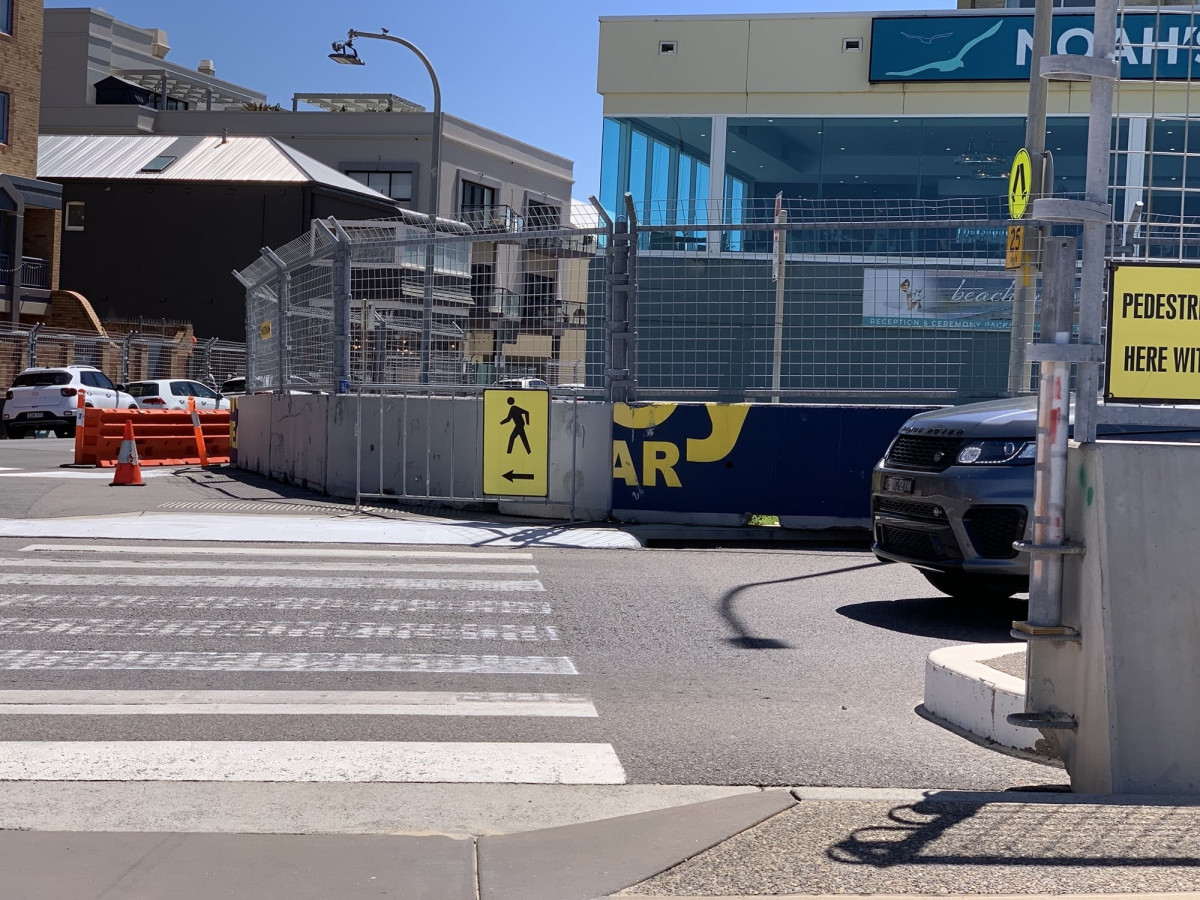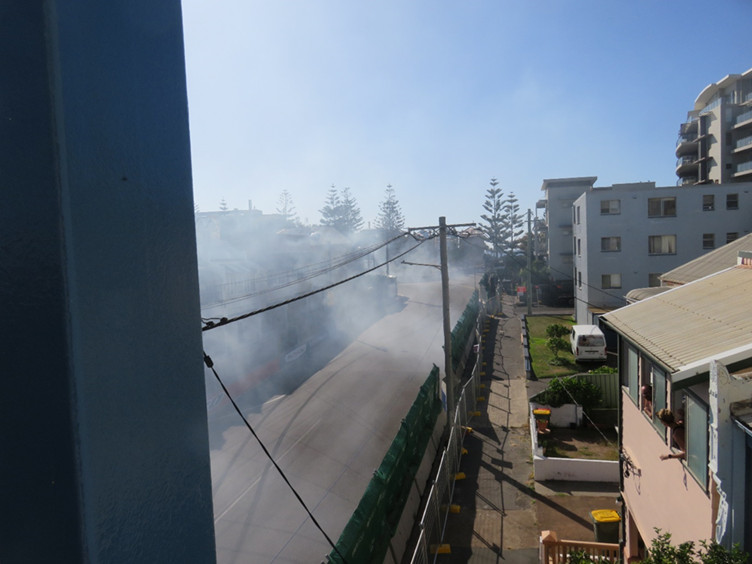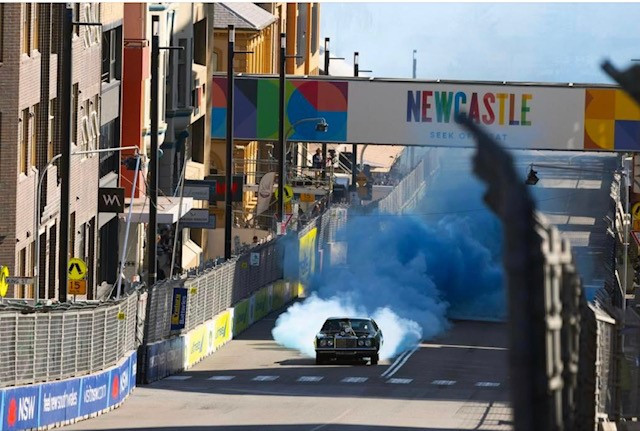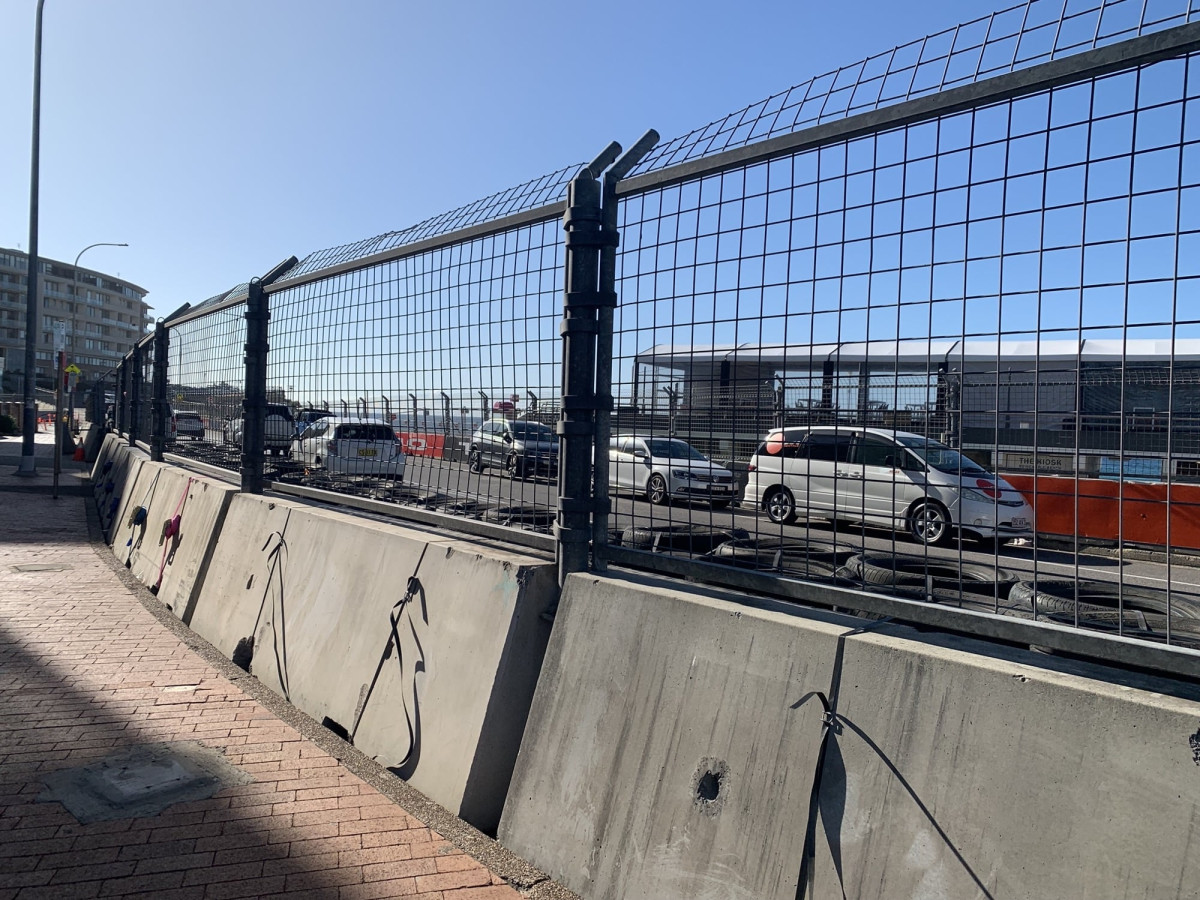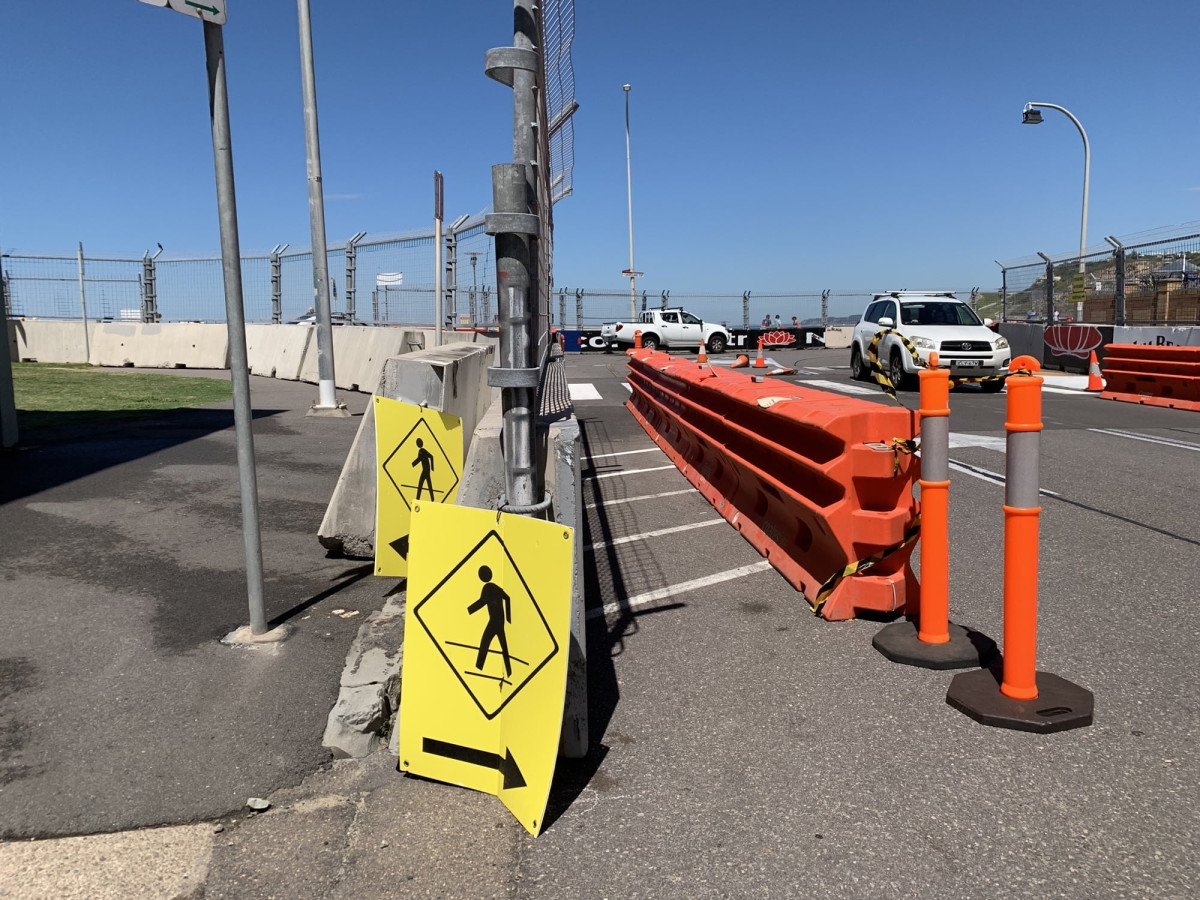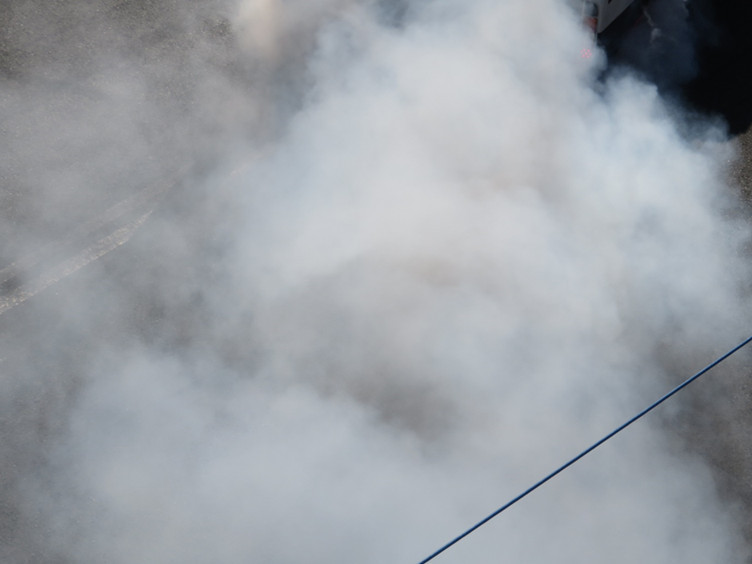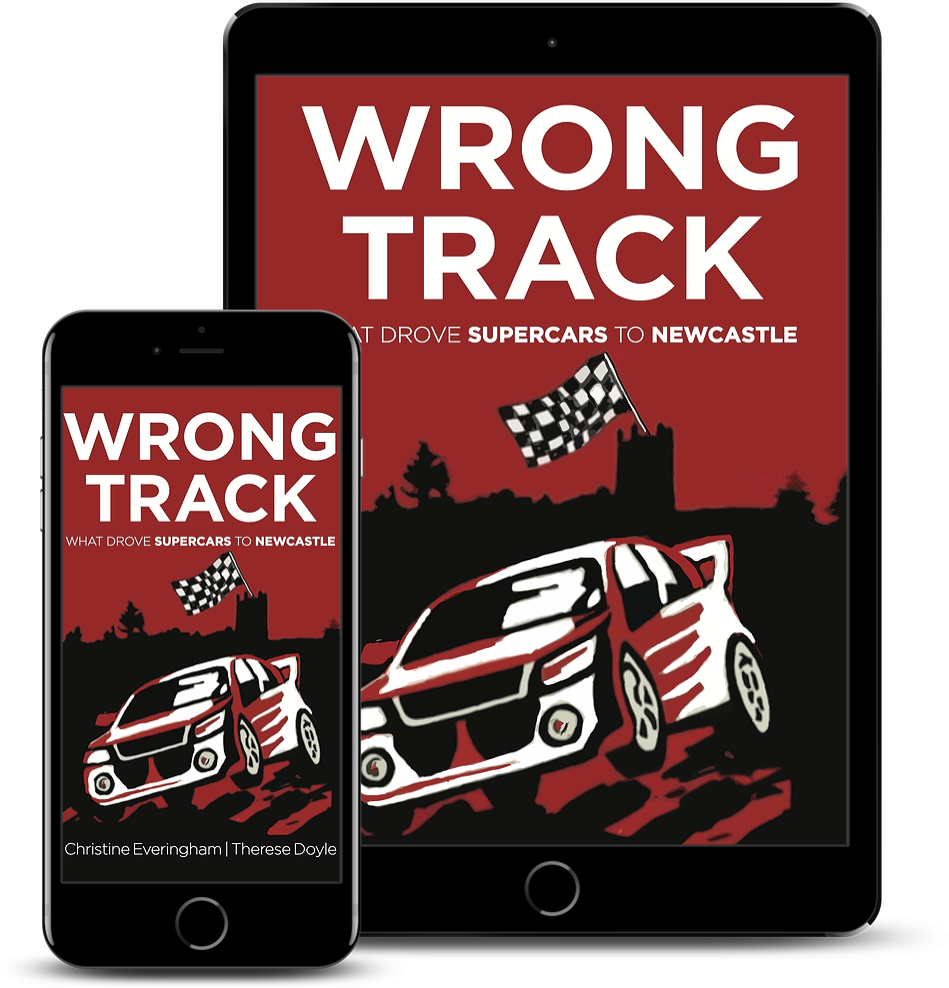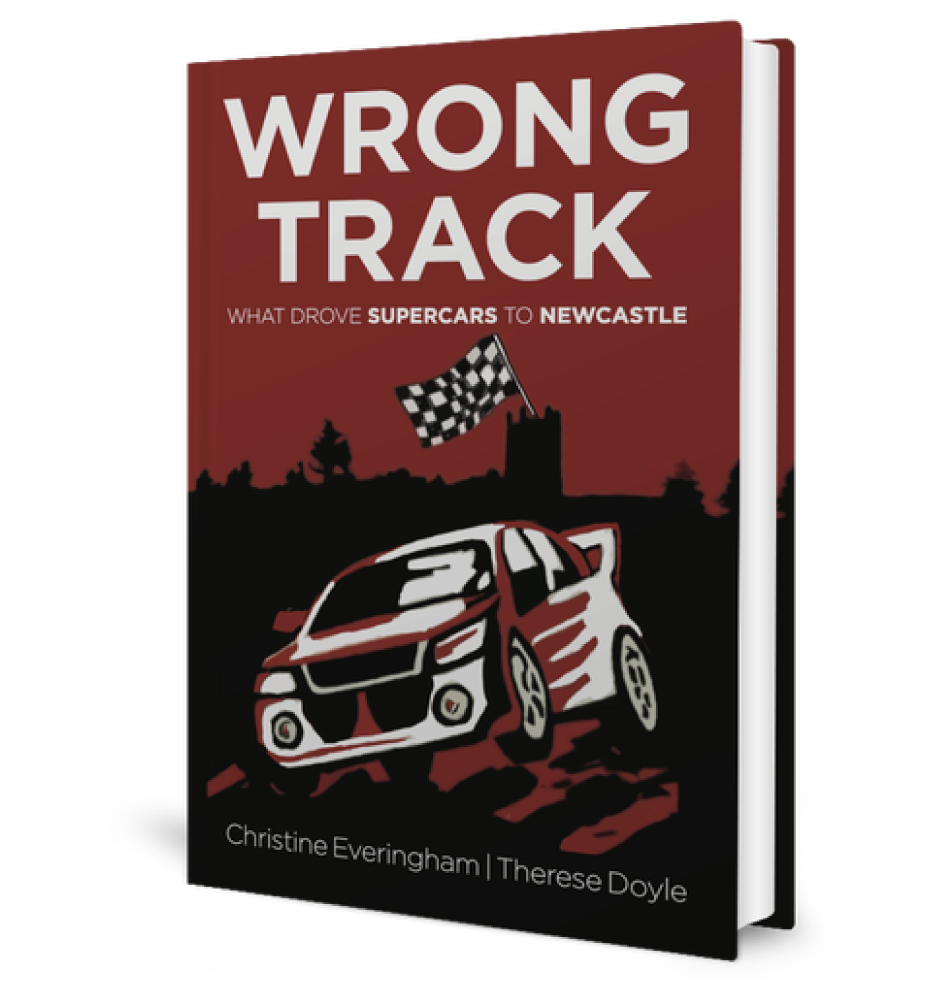2023 - Newcastle 500
The 2023 event was the last in the 5-year original agreement.
Covid 19 interrupted the Supercars calendar and there were no races in 2020, 2021 and 2022.
Rather than end the season with a grand finale, Newcastle was given the opening race on the 2023 Supercars calendar. This meant it cut into the summer season – the busiest time for local businesses (apart from Christmas).
The pedestrian underpass to the main beach was closed for days while it was reinforced with large metal plates to ensure the tunnel didn’t collapse under the large number of trucks carrying heavy concrete barriers.
The main road to the foreshore and beach precinct (Wharf Road) was closed from 1st February until 31st March. All of the parking areas east of the closure were inaccessible. Although not closed, the dog beach (Horseshoe Beach), Nobbys Beach, Fort Scratchley, the Foreshore Park, the lighthouse, the break-wall and the historic East End, were essentially cut off from the rest of the city. It is a peninsula, after all. Tourism to this iconic part of the city came to an end. As did the Surf Lifesaving and Nippers season, weddings and functions.
Coastal Newcastle was under occupation, and had to give up the beaches, the parks and popular summer activities.
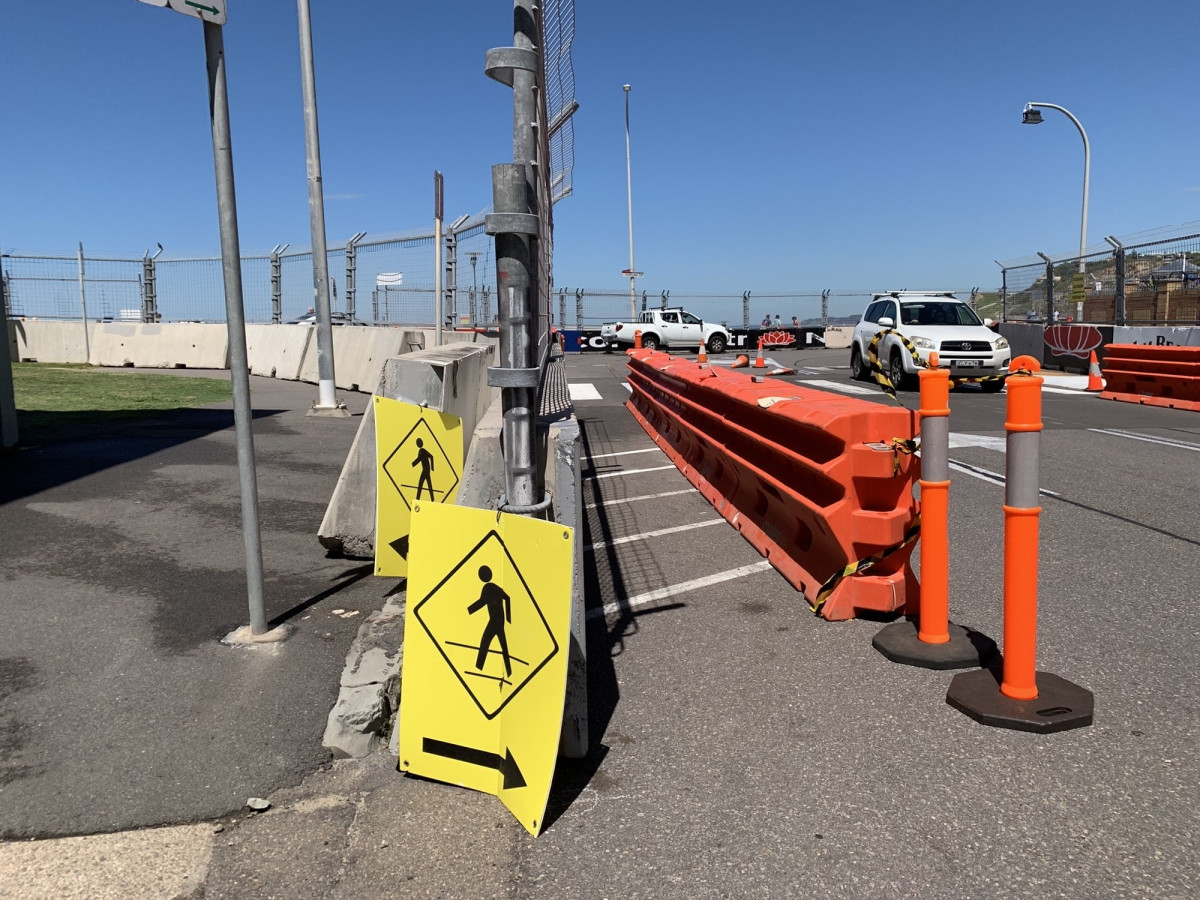
Unfold 2023 Supercars
The Economic Boom Myth
The Supercars spin is all about the injection of cash the event is supposed to provide. Evidence from the previous Newcastle 500 events and the 2023 race prove otherwise. A few hotels (Newcastle does not have many) and nearby businesses selling alcohol, were able to recuperate some losses suffered during the pre-race closure of the peninsula. No-one else was able to capitalise on the race fans as customers. We’ve seen that no matter what businesses do to try and attract fans, the reality is that race fans simply want to get into the circuit. Their only interest is the cars. Nothing else. Their food and beverage needs are met inside the track by Supercars-preferred suppliers from out of town. Not local. Photographs from every event tell the same story. While local cafes and restaurants bleed money, Supercars fans line up for fast food and beers inside the track. Businesses such as tax accountants, barbers, medical services, galleries, hairdressers, design shops, clothing stores, homewares stores, engineering companies, architects, finance advisers, gyms, lawyers etc. get NO business from the event.
And Supercars uses Gema Group from Sydney to cater for the event. All that money flows OUT of Newcastle.
The security company came from Sydney. (Previously they have also come from Queensland.) They brought their own staff with them. We had hoped the staff would stay in Newcastle hotels, but instead they had to “camp” inside the PCYC at Broadmeadow. So no cash flow to Newcastle there.
IEDM is the Supercars-affiliated company used to install the race infrastructure…based in Queensland in the same office building as Supercars. Not local.
Volunteers (there were fewer this year) were camped at Maitland showground, so did not spend money in the Newcastle LGA. No-where inside the circuit was there an opportunity to pump money back into the local economy, yet Newcastle residents and business owners pay twice for Supercars…once with their tax money and again with their rate money.
Small businesses rely on return customers, locals and foot traffic. They got none of this during the event. Darby Street (Newcastle’s eat street), outside the event precinct, but close-by, was extremely quiet. Traders there and closer to the circuit reported a decline as soon as work began on building the track. This is partly because patrons don’t want to tackle the traffic snarls, road closures and inconvenience, so they stop visiting the city. For many, that change in habit becomes permanent as they make new connections to cafes and pubs away from town. Another problem is that a huge number of locals leave Newcastle with their families in order to avoid the race. They spend their money elsewhere during the race. All that local trade is lost as well. Local businesses reported losses of 70%-75%. Some who did trade well on the Saturday and Sunday, reported that they only broke even due to the downturn in the lead up to the race and the slow return of customers after the event.
So while Newcastle residents exit the city and boost the profits of other LGAs, the Supercars fans who come in, spend their money at mostly non-local outlets and boost the profits of Sydney and Queensland companies.
In the midst of all the chaos, a cruise ship loaded with passengers arrived in port. The horrified visitors could not access any of Newcastle’s historic, environmental or cultural features. The best of Newcastle’s iconic beaches, monuments, coastal walks and parklands were hidden behind ugly fences and barricades. The cruise passengers were transported to other LGAs to spend their money – and will probably never return. It is almost impossible to conclude that approximately $30 million is ‘injected’ into the economy when our city is deserted. The Supercars event impacts negatively on the city due to two important factors: displacement and leakage. Displacement is a measure of the volume of normal activity displaced by an event. Leakage is money that is NOT spent in the host community but goes OUT of the local community. For instance, when race patrons stay at international hotel chains, rather than locally owned ones.
Displacement and leakage are especially damaging in Newcastle due to the lengthy time the event and the infrastructure is here.
It’s obvious that the money spent by our ‘visitors’ did NOT go into the Newcastle economy but instead made its way out of Newcastle via non-local traders and contractors.
The dollars flowed to the food vans, alcohol suppliers, the sponsor merchandising, equipment hire companies and NOT to Newcastle businesses. On Saturday night Hunter Street restaurants were nearly empty, yet on a ‘normal’ Saturday they would be operating to capacity.
There are many thousands of people who are not interested in the event, don’t go to the event even though it is in their city and avoid all areas of the city that are affected by the event. There is a mass exodus of families out of Newcastle. This means that the local spend economy (normally regular and sustainable) is taken to other LGAs.
The money doesn’t stay in Newcastle. Local businesses have data that shows the correlation between business downturn and the period of time that Supercars occupies the city. CON and the state government bolster the economies of other regions by absorbing all the race costs and race disadvantages here in Newcastle.
Newcastle people deserve to know the truth behind the spin. CON’s costs are hidden in the way they publish budget statements. For instance, the roads for the circuit must be resurfaced before each event (under the terms of the agreement). Yet there is no mention of the Supercars road program in council documents. Instead, the cost is included (and hidden) in ‘general road maintenance’ for the whole city. Ludicrously, the new road through the Foreshore Park behind Nobbys Beach (only used for 3 days each year) has to be resurfaced before each event, under general road maintenance, even though it is only used by Supercars on the 3 days of racing.
Looking at the Supercars event this year, it is apparent they are tightening their belts. Shortcuts and cutting corners were frequently observed. The main reason for locating the concerts inside the circuit would have been to keep patrons captive, so that they ate and drank inside the Supercars compound rather than going for dinner outside. This had the effect of adding to their Supercars profits, while reducing patronage at local cafes and restaurants.
We have seen in previous events how slowly the uptake for local businesses is during and after the bump-out. People know from experience that road closures and dismantling operations last long after the race is over. The Newcastle 500 is NOT just for three days! By the time Supercars moved the circus on, the summer was well and truly over. Any opportunities to capture the last of the summer trade season were lost.
The Chaos of the Bump-in
Supercars began what would be the worst of all the highly disruptive track-builds. Destination NSW was originally the agency with oversight for the race. This all changed with the passing of a new Motor Racing Act: Motor Sports Bill 2022. Destination NSW rid itself of responsibility for the race, bequeathing it to the Office of Sport.
The Office of Sport’s core business is managing Sport and Recreation Camps and promoting active recreation. It has no expertise in running and overseeing a motor racing event, let alone one whose location creates such a headache for the stakeholders.
And the disorganisation of this year’s race demonstrated their unsuitability very clearly. It was chaotic from beginning to end. Destination NSW wiped its hands of all responsibility saying it was simply a sponsor of the race. Minister for Sport, Alister Henskens and Office of Sport did nothing, knew nothing, did not answer complaints, and simply let Supercars do whatever they wanted.
In the lead-up to the race, multiple roads were closed simultaneously, traffic was gridlocked, clearway signs were installed on the wrong streets, cars were towed without warning, fencing was installed in front of homes earlier that in previous years, more trees were lopped or cleared, Build Notices were delivered inconsistently then the information was changed without notice…it was shambolic. Parents at the local Day-care centre were fined when they dropped off their children without knowing (or being notified) that a bus stop had suddenly replaced their drop-off zone. Commuters sat at their normal bus stop, not knowing it had been re-routed by Supercars. The removal of traffic calming devices left pedestrians at risk in our beach suburb. The barriers created blind corners and pedestrians were directed to walk on the road, separated from traffic by string tied to plastic bollards.
There were no traffic managers in place. Motorists were so confused by the signage and ever-changing conditions that road rage became the norm. The minister responsible, Alister Henskens, (Minister for Enterprise, Investment and Trade, Minister for Sport) rarely responded to complaints and deflected any correspondence to Supercars or the Office of Sport (who didn’t answer emails).
Things deteriorated so badly, WorkSafe NSW was brought in to investigate complaints of dangerous practices and advise contractors about what safety measures needed to be put in place. During the construction of the track, a car collided with a tram, a car crashed into the concrete barriers at the Zaara Street corner, many pedestrians had near-misses, a crane crashed into two parked cars, the concrete barriers were placed across driveways on two streets blocking residents’ cars in, forklifts were travelling at speed along public roads, workers were using power tools on the pedestrian footpath at Newcastle Beach while beach-goers walked nearby, busy pedestrian crossings had no traffic wardens to slow and stop vehicles, cars drove straight across intersections where roundabouts had been removed and in busy pedestrian areas Supercars had erected witches hats and string to divide walkers from traffic .
The Supercars Community Fun Day
A meet-the-drivers day was advertised widely. It was held in Civic park (18th March) and the media spin talked of free tickets, merchandise and driver autographs. There was a jumping castle, football passing and some other nondescript kids activities. It was a flop. Few people turned up, and the drivers and staff sat around playing on their phones. Photos taken every hour show an almost empty park. The Herald could only muster up this underwhelming statement “Supercars fans turned out for the Coates Hire Newcastle 500 Community Fun Day. Hunter residents were again given their chance to get tickets for this year’s supercars event, which will take place in the streets of Newcastle from November 23-25.”
The Concerts
Supercars made the decision to hold the concerts in the race precinct in 2023. The 2019 concert was due to be held out of the race precinct to give residents respite from the noise and chaos of the event. In the end, that Kiss concert was cancelled, and there was a huge fan backlash. This year’s concert location took residents by surprise. Expecting it to be away from the precinct, they had hoped for some quiet at the end of the day’s racing. On the Friday night, the line-up appealed to an older audience, and on the Saturday night the Hilltop Hoods were expected to bring in the younger fans. Neither concert attracted the numbers that attended the Jimmy Barnes concert in 2017. The Saturday concert had a larger, louder crowd.
Many people, not interested in motor racing, but wanting to attend the concerts, were forced to buy tickets to the motor event in order to access the concerts. There was much dialogue on social media, where people complained that they couldn’t buy a separate concert ticket.
To counter the surge of concert-goers into the “residential-only zone”, residents asked for the secure zone to be kept closed until concert attendees left the precinct. The police commander gave assurance on the Thursday before the event, that the fencing would be secured until 7:00 pm each night, when it was expected that the majority of concert attendees were already at the concert. A request to Supercars to secure the fencing until after the conclusion of the concerts was refused, and a statement issued saying that the gates would only be secured until 7:00 pm at night. (Police gave an undertaking that they would increase personnel in the resident zone after the gates were opened at 7:00 pm.) The fences had signs at each opening notifying that the resident-only area would be secure from 7:00 am until 7:00 pm.
On the first day, the area was flung open before 6:00 pm and race patrons were able to access the whole area. Urgent emails to Supercars went unanswered. The area was opened every night before 6:00 (when concert attendees were streaming into the precinct) despite calls for the original times to be upheld.
In previous years secure fencing prevented patrons from entering the resident precinct via the garden slopes on the edge of the Supercars compound. No fencing was installed for the 2023 event, and patrons infiltrated the area from a number of entry points. Supercars finally sealed one small entry point many hours after residents complained, but did not seal any of the others. Patrons at the Saturday night concert used the community produce garden as a de facto toilet. One of the long term custodians of the garden was in tears of despair after seeing intoxicated concert goers urinating on the plants.
Denying Access to Residents
Many of the remaining residents (most left with their children and pets) chose not to register for wristbands to enable them to enter and exit their own homes. Any proof of identity and residential address is all that is necessary (and at the same time, an affront to personal freedom). Despite assurances that security staff would be informed about accepting alternative documentation, many residents were challenged and denied entry. Several asked gate staff to call police to let them in. After being refused entry, one resident waited for 20 minutes before police arrived to allow the resident to walk home.
Purpose Built Track
There is a particular lunacy in holding a car-race in this location. Yes, the TV images (when they pan to the surroundings) look great. The coastal city is beautiful. The peninsula is perfect for passive recreation and the fort and lighthouse look stunning. (In 2023, the footage included happy bathers enjoying the facilities at Newcastle Ocean Baths, despite it being closed and undergoing major reconstruction.)
But any coastal environment and motor racing are at opposite poles. Fans would attend the race wherever it is held. In fact, the compound is surrounded by black plastic walls preventing views out to the harbour and beaches. There is an alternative. Circuit Italia – 15 kms north of Raymond Terrace could accommodate Supercars next March. Just imagine – real benefits without the disruption.
This is the solution that real motor sport fans want. For example, in 2016, Former Formula Ford champ Russell Norden said a “A very big thank you to [Central Coast Council’s] Rob Noble for drilling down and seeing what a ridiculous waste of (how many?) millions of dollars it is to build a circuit that only lasts for 4 days! It is absolute madness! We need to spend those millions on a permanent motor racing circuit that is of benefit 365 days of the year. It then benefits the sport, it benefits local businesses, it can be used for driver training, for functions, for car launches, for just about anything because it is PERMANENT and it is always there, 365 days of the year!”
On a purpose-built track fans could actually see cars racing– and cars could have ample opportunities to overtake. The Newcastle track has severe limitations. It does not meet the basic minimum width for street circuits in several places, relegating the race to a single-file fast drive-by.
Visitors could stay in Newcastle, visit Port Stephens and the vineyards and take the opportunity to extend their stay and experience the city without the restrictions and constraints that the race imposes. It could be a win-win. It should be a win-win.
Relocating it to a purpose-built track and keeping the city open and accessible to all while the event is on offers wonderful opportunities. The concerts could still be held in the city. We could have a cultural/artistic/foodie/craft beer/surf comp/music vibe in town and the car racing at the track. Accommodation providers, hospitality, shops, services parks and playgrounds and sporting fields could still operate as usual. There is the prospect of a value-added visitor uptake if the event appealed to a more diverse audience. The possibilities are endless. If it was held outside the city, we would not have the mass evacuation of locals (that increases with each event) and our local traders would reap the benefits.
Our business community would be able to make something amazing happen IF the race wasn’t in the city!
The “Priest”
When this same event was held at Olympic Park in Homebush, it was coordinated by a specially appointed government Advisory Board and an Event Management Committee consisting of representatives from the 8 government agencies directly involved.
Instead of a designated person in authority to contact if problems arose, residents were given the community contact for an employee of the promoter, Supercars. The circuit encloses over 3 000 residents including 3 public housing complexes for seniors and hundreds of small businesses. With no experience or expertise, the Supercars employee struggled to cope with the demand, evidenced by so much delay in response time – if he responded at all.
Chris Yates appeared to have no ability to troubleshoot problems. Residents and business owners have reported his many inappropriate statements when discussing issues with anxious and upset business-owners and residents.
“Supercars didn’t ask you to have a baby” when asked by a young mother if her application for relocation (submitted weeks prior) had been approved.
He claimed he was a priest associated with St Mary’s Catholic Church, at a meeting on Friday 23 February, and on multiple occasions he asserted that because he was a priest he literally couldn’t tell a lie, and that he always told the truth. He made mention of occasions when he wore the “dog collar and robes”.
When asked what church he belonged to, he made a motion in the direction of St Mary’s and specifically stated the name.
Whilst refusing Watt Street residents parking in the Bolton Street carpark, he lamented that during the race, probably race goers would be parking in “his” carpark at St Marys.
But St Mary’s is a ceremonial-only church. There are no clergy based there. (Investigations revealed he was not associated with the Catholic Diocese and hired the church on Sunday evenings to “preach”. When alerted, the Bishop revoked his hire contract with the church.)
“You have to show evidence of vulnerability” to another young mother with a ten-week-old baby.
He said he “had no skin in the game” … perhaps trying to give the impression he was neutral, but then told other residents he worked in the control room for Supercars at Bathurst.
“I get paid a lot of money to listen to you” he mentioned four times to a distressed shop owner.
“Supercars loses money in Newcastle” to a resident who needed alternate parking close to home because of impending knee surgery…an offer was made to accommodate the car in a cheaper, unsuitable carpark on the other side of town.
The liaison officer insisted residents on Watt St. (right ON the track) were “outside” the event zone. Supercars used this excuse for not providing parking for them, despite the track closing all access to their shared lane for off-street parking. The legislation definition and signs as far down as the mall, and Darby Street declared all the area an event zone. Supercars simply changed the definition of the legislation to suit themselves.
Chris Yates promised to seal the Watt Street residents’ back lane which goes through to Bolton Street and gives access to the Grand Hotel. They sent many messages asking that it be closed to the public. It was never done and as expected, non-paying fans used the lane to access the residents’ front yards, standing on their balcony fences to watch the race over the sound curtains. Requests to have the non-residents removed from their properties were ignored.
When one resident showed him conflicting accreditation advice from Supercars, he said , “they’re from QLD” – his way of reminding all that he’s “a local” .. (he pushed that few times) but offered no solution or reasonable explanation.
Ultimately, Chris Yates wasn’t able to accommodate most residents’ and shop owners’ requests and stopped responding to the many emails of complaint.
Hearing Damage and the Noise
To mitigate against the demise of Holden-Ford rivalry, in 2023 ‘Gen 3’ cars were launched as an attempt to give fans a ‘new’ racing experience. Sound monitoring has determined that the new cars appear louder than the Supercars over a longer period of time. Sound recorders installed and monitored by RCA showed Lc peaks that ranged between 120dB and 130dB.
If you are exposed to the high levels experienced close to the track, then the dose is many times that of the regulated LAeq(8 hour). In practice that means exposure may be ten days or more dosage during a two hour race, depending on where you stand.
As a comparison, the mining industry has a set limit of 115 dBL which can be exceeded on a number of occasions. But no level can exceed 120dBL. (This is in an industry that drives about 30% of Australia’s exports and indeed services coal exports through the Port of Newcastle – not just a private car company relying on government hand-outs to exist).
Mining blasts of 10 seconds, 100 times (twice a week) a year, equates to about 20 minutes total duration. This compares to 240 minutes for the two weekend races in the Newcastle 500. Bear in mind that residents in the Hunter Valley are generally some distance away from the noise source. At the Newcastle 500 people are immediately adjacent to the noise source – and the vast majority do not wear hearing protection.
Residents are not protected by WHS conditions (unlike Supercars employees). Local business owners must protect their own workers under the WHS law, yet are not adequately informed.
On the Friday of racing, school students were photographed in Scott Street within metres of the track. The noise levels LC peak were > 120 dB. Few children wore hearing protection and they were only metres from the noise source. The maximum noise level at that location was 127 dB LC peak while they were there, and may have been higher elsewhere. There were many students around the track, standing next to the barriers, exposed to damaging levels. Although notified of the noise levels and failures to police hearing protection in previous years, the Department of Education continued to ignore the safety of the children.
Lack of Oversight
Unfortunately we have grown very used to Supercars getting things wrong on a daily basis. This has occurred during every event staged in Newcastle. Worse though, is having so little recourse to get anything fixed or to get replies from anyone associated with the event.
It is reprehensible that the Minister for Sport and the Office of Sport refused to have a full time presence on site before the works commenced. As the authority for the race, they should have played a more active leadership role in what is a complex Civil Construction project, and one that is known to be fraught with difficulties. Perhaps some of the problems would not have occurred and residents and business owners wouldn’t be of the opinion that it has been the most disorganised bump-in process yet, despite it being the fourth time they have carried out the identical procedure. By turning a blind eye to community concerns, the Minister and Office of Sport have relied on hope as a plan. That’s risky. At the very least, there should have been an independent entity for people to speak to about their concerns. To quote one business on a Facebook post, Newcastle East is “a community about to combust with anger and frustration”.
Council Secrecy & Non-Disclosure
Council has commissioned two benefits-only reports. Neither report examined the many costs associated with the event. Neither report subtracted the costs paid by ratepayers, taxpayers, local businesses and residents.
Interestingly, the two reports came up with vastly different figures for the number of people in the event space during the 2017 event. Supercars’ official attendance record for that year was 292 242. The Hunter Research Foundation Centre (HRFC) used Telstra data and found ‘77 600 people who ordinarily reside outside the event space were present in the event space area.’ To account for the similarities in their respective economic impact reports, despite these vastly different numbers, the HRFC then used multipliers to boost the impact result to $30.1 million. This sleight of hand method was employed despite ABS advice that multipliers should not be used for assessments of benefits for regional projects. The ABS discontinued their use after considerable debate in the user community as to their suitability for the purposes to which they were most commonly applied. That is, to produce measures of the size and impact of a particular project when supporting bids for industry assistance of various kinds. Council’s EY Economic Impact Report of 2021 reverted to using Supercars attendance figures for all 3 years, including the 292 242 2017 figure.
The Numbers Game
What is the justification for the 9 weeks disruption to our prime tourist destination in peak season for 9 weeks every year? It’s impossible to tell from the attendance count because the numbers of race patrons who come through the gate are not released. Only the ‘tickets issued’ by the promotor are made public and most of these are free and counted whether people come or not. It’s impossible to tell from local and state government reports on its economic benefits because these agencies use these same figures to calculate overall ‘visitation’ benefits. It’s impossible to depend on media reporting of the event because the media are very likely to be sponsored by Supercars.
An accommodation search was undertaken on 20/02/23. The search looked at Newcastle and surrounding areas. The number of properties with vacancies from Friday 10/03/23 until Sunday 12/03/23 was:-
Trip Advisor (Hotels) – 104
Trip Advisor (Apartments) – 64
Air BNB – 300
One of the few businesses that should benefit from Supercars is accommodation. But the figures show that it doesn’t appear to be the case. Following loss of bookings during the lockdown of the precinct from February 1st, the results are troubling.
There is no available count of people who actually pass through the gate – all benefits are worked out on ‘tickets issued’. This includes the many thousands of free tickets given away. There is no way of knowing if recipients of free tickets actually attend the event. For the last 3 events between 60% – 70% of the ticket count was issued directly by Supercars accreditation department i.e. given away free.
NERG revealed that results of a Freedom of Information application for ticket data showed that ticket recipients were counted as racegoers even if they did not attend.
Without a verifiable set of attendance figures – any consultation report, announcement of economic injection or estimate of crowd numbers cannot be objective.
Yet, Supercars DOES know how many actually pass through the gate. Everyone who comes to the event is scanned. The simplest way to determine and defend the accuracy of attendance claims is to require Supercars to produce those scanned numbers.
Successive governments and councils will need to develop a more believable narrative about why this event is being imposed on the city in the first place. The idea that it is good for tourism is laughable given the 2 months occupation of the city and its extensive barricades, scaffolding and closure of roads and car parks. V8s racing through heritage streets hardly presents an image of a city looking to lead the world in the transition to a greener economy.
The Viewing Myth
Claims of world-wide audiences are fanciful. The highest maximum number of viewers for 2023, combining FTA and Fox was 344 000 viewers. In a media release commenting on the 2019 event, CON claimed: ‘According to Supercars Australia the TV audience for Newcastle 500 peaked at more than 1.8 million viewers with an average of 1.3 million people tuning in to the three-day event’.
Here is a summary of FTA and FOX over the 3 days.
FRIDAY
On STV (SEVEN) Supercars did not make the top 20.
On STV Fox, Supercars ranked 10th (67 000) after the cricket (305 000) and Footy (118 0000.
SATURDAY
On FTA Supercars did not make the top 20.
On STV Fox there was no mention of Supercars in their overall summary: ‘Fox League dominated subscription TV with NRL coverage. Super Saturday: Round 2 topped the night with 346 000 views, followed by the Dolphins v Raiders match, which saw the newly-formed Dolphins claim victory with 20-14 in front of 332 000. Later in the night, Bulldogs dominated Storm 26-12, pulling in 309 000, while the Roosters v Warriors match clocked 192 000. Supercars ranked 7th (133 000) after No 1 Footy (346 000) and cricket (164 000).
SUNDAY
On FTA Supercars ranked 15th (197 000) behind No 1 Married at First Sight (867 000).
On STV Fox, Supercars ranked 4th (147 000) behind the footy (254 000).
TOTAL
So, combining FTA and Fox, the maximum number of people viewing at any one time this year was 344 000.
In a media release commenting on the 2019 event, CON claimed: ‘According to Supercars Australia the TV audience for Newcastle 500 peaked at more than 1.8 million viewers with an average of 1.3 million people tuning in to the three-day event,.
Even allowing for media spin, that’s a big drop from the numbers claimed in 2019.
Additionally, newspaper interest was poor everywhere. In the Sydney Morning Herald on Saturday, there was no mention of the race – not even in the Sports pages!
If you searched SMH online VERY hard there was a 23 second video with no story. It only showed two cars on the track, no scenery. The printed Sydney Daily Telegraph (in approximately 30 pages of sport, had a half-page photograph of the winner. No scenery . The text was about the dry ice controversy. The word Newcastle was mentioned once and not in the headline. The printed version of the Australian had a similarly small article with a picture of 2 cars. It appears the event is struggling to ‘put Newcastle on the map’.
Council Kickbacks
CoN received 300 free tickets as per the benefits of the first services deed. This was increased to 500 tickets in the new Variation that CEO Jeremy Bath signed. Council could distribute them as they liked. The NSW government also got free tickets, in addition to a fully-catered corporate box and a TV screen. We are no longer informed about who council invites to their fully-catered party at Fort Scratchley, but in 2017 the guest list included 44 MPs and Senators at a cost of $40 000 (rate money).
One councillor, John Church requested details about the VIP events. He asked the CEO who had been invited, and the costs etc. He was told the information would be supplied AFTER the event. He was also told there would be 400 staff attending an event at Fort Scratchley on Friday 10th. He was not told how many VIPs were attending on the Saturday.
The public deserve to know more about the VIP function that gathered together all the politicians and ‘stakeholders’. No doubt they congratulated each other and made plans for the next 5 years. Providing tickets to council and NSW politicians was part of the “Benefits” listed in the Strategic Agreement/Services Deeds. The very idea rubs salt into the wounds of those who bear the considerable costs and are not compensated under the Motor Sports Bill!
In the first year there was extensive information made available via GIPA. We learned the costs AND were told who was invited, resulting in a public backlash for the Lord Mayor. Consequently, by 2019, nothing was put in writing! There was no guest list amongst ALL minutes taken by the Project Control Group for the 2019 event and all that was available through GIPA was the costs. If the guest list included the people likely to be directly involved in the decision about the future of this event, then it should be public knowledge. We know that in 2017 there were 39 politicians invited from BOTH main parties, along with Professor Will Rifkin (who oversaw the first benefits-only race report for council) and Bob Hawes and trade union officials.
The Lord Mayor (who was instrumental in bringing the event to Newcastle) persists with the narrative that the bump-in and bump-out can be better. It can’t. You cannot hope to build a motor racing circuit through a heritage precinct on a peninsula in 5 weeks, close major arterial roads into the city and Foreshore and expect it to NOT result in chaos!
Crowding Out of Other Events
The sudden decision to host the opening season of the series in Newcastle meant that summer events already committed to had to be relocated away from the city and the Foreshore.
Summer finals and regular Nippers activities at the local surf life-saving clubs were cut short and the season was unfinished.
The Newcastle Fringe Festival had to find alternative venues in outer suburbs. Weddings and receptions already booked many months ahead, took place with a backdrop of concrete, wire and construction machinery.
The popular Newcastle Beer Festival, always held in the East End precinct and Honeysuckle, had to be moved away to King Edward Park – a far more unsuitable venue.
The location of the race is completely unsuitable. Other street circuits (Bathurst, Adelaide, Townsville and Gold Coast) do not shut their cities down and exclude everyone from iconic city destinations for months. These other circuits have the advantage of multiple routes in, out and around the circuit and race precinct. In Newcastle the limited number of roadways into the peninsula are cut off by the circuit for months. In this location, the race locks in more than 3000 residents (including three complexes of public housing for the elderly) and forces the closure of hundreds of local businesses because clients and customers cannot access the site.
The Public Purse
It is time for ministers and state government agencies to order an Auditor General’s Report. Homebush, Hamilton and Canberra have all been audited with damming results. The Newcastle 500 is due for one!
Instead, of the benefit-only reports commissioned by CoN, councilors must push for an Auditor General’s cost benefit analysis, before any further decisions about the race are made.
Supercars is a private company. It depends on government funding to exist. Large subsidies from state and local government bodies allow it to continue. Newcastle people pay for the race twice – with taxes and rates.
The race in Newcastle costs Supercars very little. An extraordinary amount of council money is spent on providing services for this private company. The official figure of $1.6million is as ludicrous as it is impossible. CoN pays Supercars $500 000 just as an appearance fee! The road grinding and resurfacing is hidden in the council budget under city road ‘general maintenance’. Those 2 items alone, would account for the budget CoN says it spends.
The Environmental Cost
Every event, Supercars requires more clearing of shrubs and trees. 2023 was no exception.
In total, the Foreshore parks and streets have lost more than 200 trees. A greater number of trucks and machinery had to be stored in the park due to the loss of The Station as a storage area. If there were branches in the way, they were simply cut off.
Weeks of heavy truck movements transformed the grassy areas of the park into a dusty wasteland requiring many months of rehabilitation (at council’s expense).
The rubbish, take-away containers, plastic cups, plastic straws and plastic bottles is a land fill catastrophe.
Thousands and thousands of plastic cable ties are used to secure black plastic to fencing all over the precinct. During the dismantling of infrastructure, as in previous years, the ties were cut off and left on the ground, roads, park gardens, gutters and footpaths.
The new Dunlop racing tyres used in 2023 were softer than previous ones. They disintegrated over the course of the day, leaving the equivalent of almost 300 tyres broken into various sized pieces. Tyre rubber was flung all over the roads, gutters, footpaths and parklands. Much of the plastic and rubber was swept into drains or was washed into drains when heavy rain fell before it was removed from gutters. Days after the race, pieces of tyre rubber of varying sizes could be seen on the sand at Newcastle Beach.
Burn-outs contributed unwelcome and unnecessary air-borne pollution in close proximity to residential homes on the track. It appeared the burnouts were aimed at residents, since they were performed on parts of the track that spectators were excluded from.
